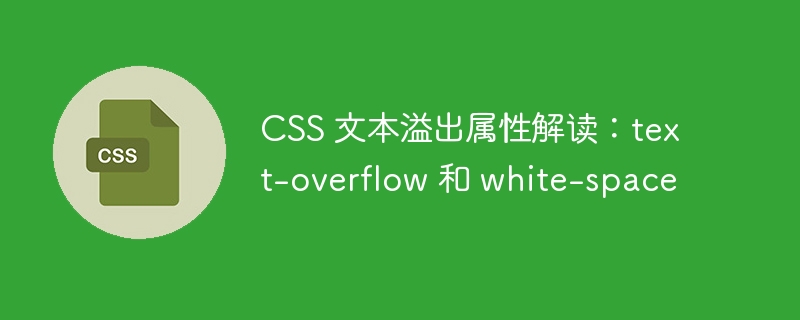Home >Web Front-end >CSS Tutorial >Interpretation of CSS text overflow properties: text-overflow and white-space
Interpretation of CSS text overflow properties: text-overflow and white-space
- WBOYWBOYWBOYWBOYWBOYWBOYWBOYWBOYWBOYWBOYWBOYWBOYWBOriginal
- 2023-10-21 10:28:501331browse

Interpretation of CSS text overflow properties: text-overflow and white-space, specific code examples are required
Introduction:
In web design, we often encounter When the text content exceeds the width or height of the container, we need to take some methods to deal with the overflowing text. CSS provides some properties to help us control text overflow, the two most commonly used properties are text-overflow and white-space. This article will introduce the characteristics of these two properties and how to use them, and provide specific code examples.
1. Text-overflow attribute
The text-overflow attribute is used to specify how to handle text when it overflows the container containing it. It has three optional values:
- clip: The default value means that the overflowing text content will be clipped and hidden outside the container, and the overflowing part will not be displayed.
- ellipsis: Indicates adding an ellipse at the end of the overflowing text content.
- inherit: Indicates inheriting the value of the text-overflow attribute from the parent element.
Here is an example showing the use of the text-overflow: ellipsis attribute:
.container {
width: 200px;
white-space: nowrap; /* 文本不换行 */
overflow: hidden; /* 超出容器宽度时隐藏溢出内容 */
text-overflow: ellipsis; /* 溢出文本末尾添加省略号 */
}By setting the container to a fixed width, disabling line breaks, hiding overflow content, and By adding an ellipsis at the end, we can achieve the effect of omitting text when the width of the container is exceeded.
2. White-space attribute
The white-space attribute is used to control the arrangement of text in the container. It has the following values:
- normal: The default value, indicating that the text will be wrapped and combined with spaces based on whitespace characters.
- nowrap: Indicates that the text will not wrap in the container and the overflow part will be hidden.
- pre: Indicates that the text retains its original format in the container, line breaks will be retained, and spaces will not be merged.
- pre-wrap: Indicates that the text retains its original format in the container, and newlines and spaces will be retained.
- pre-line: Indicates that the text retains its original format in the container, line breaks will be retained, and spaces will be merged.
The following is an example showing the use of the white-space: nowrap attribute:
.container {
width: 200px;
white-space: nowrap; /* 文本不换行 */
overflow: hidden; /* 超出容器宽度时隐藏溢出内容 */
}By setting the white-space attribute to nowrap, we can make the text in the container There is no line wrapping in the container, which hides text that exceeds the width of the container.
Conclusion:
text-overflow and white-space are two very useful CSS properties when dealing with text overflow. By using them together, we can control how text is displayed so that overflow is automatically omitted or hidden. At the same time, we can also adjust the combination of attribute values according to specific needs to achieve different text overflow effects.
In addition to the usage in the above examples, these two properties can also be used in combination with other CSS properties, such as the overflow property to handle the display of overflow content. I hope that through the introduction of this article, readers will have a better understanding of the use of text-overflow and white-space attributes, and can handle text overflow problems more flexibly in actual development.
The above is the detailed content of Interpretation of CSS text overflow properties: text-overflow and white-space. For more information, please follow other related articles on the PHP Chinese website!

